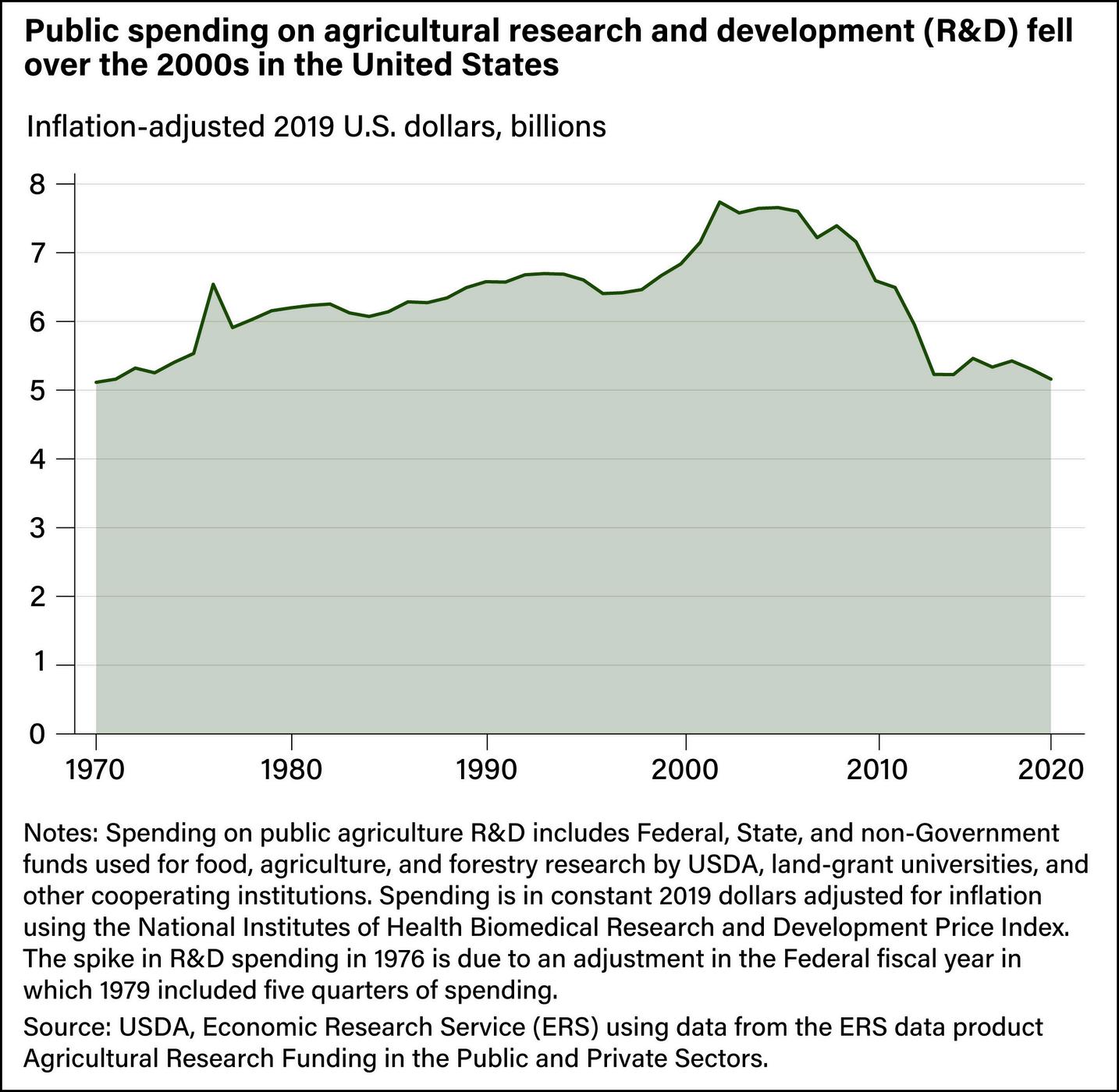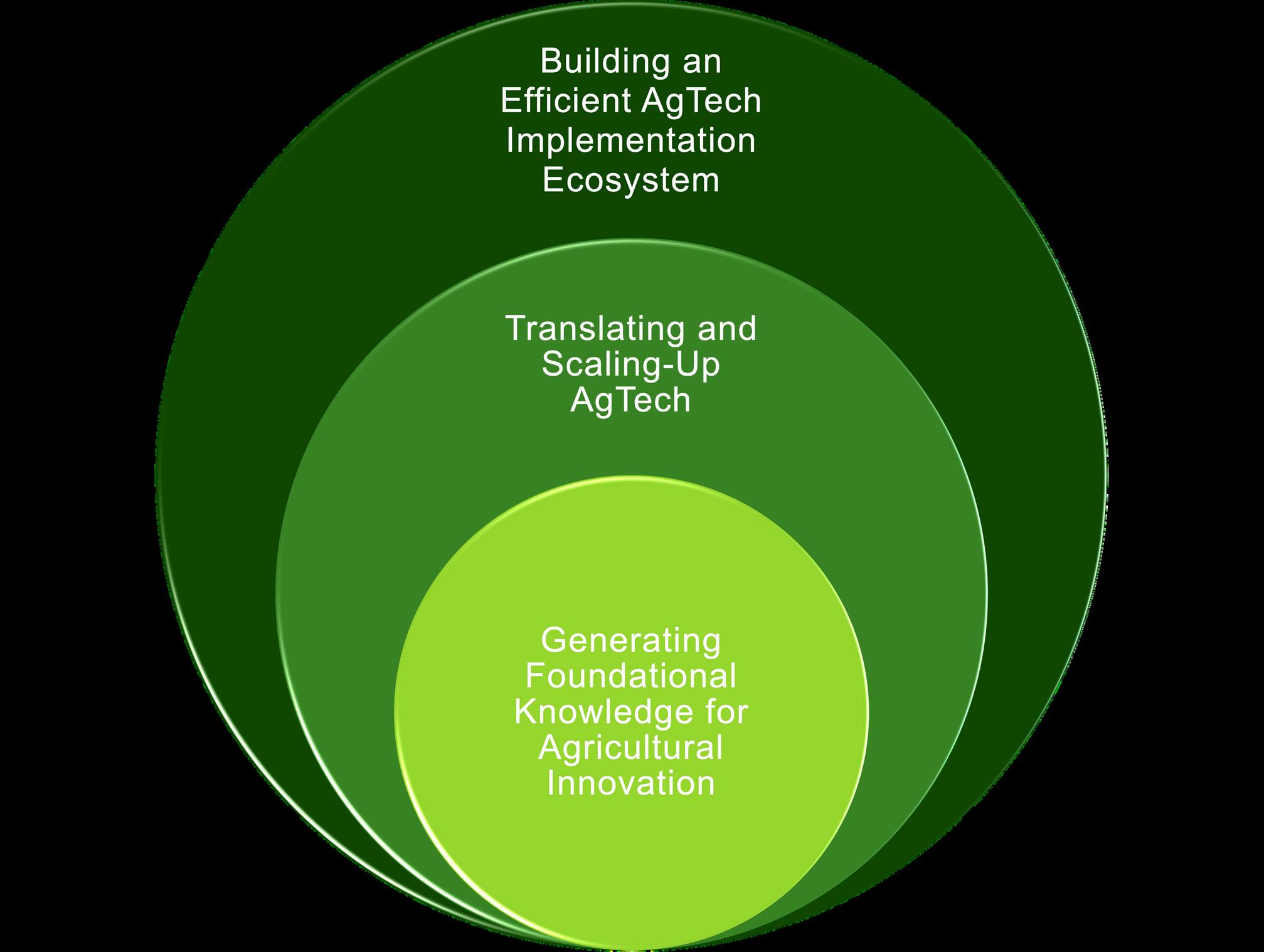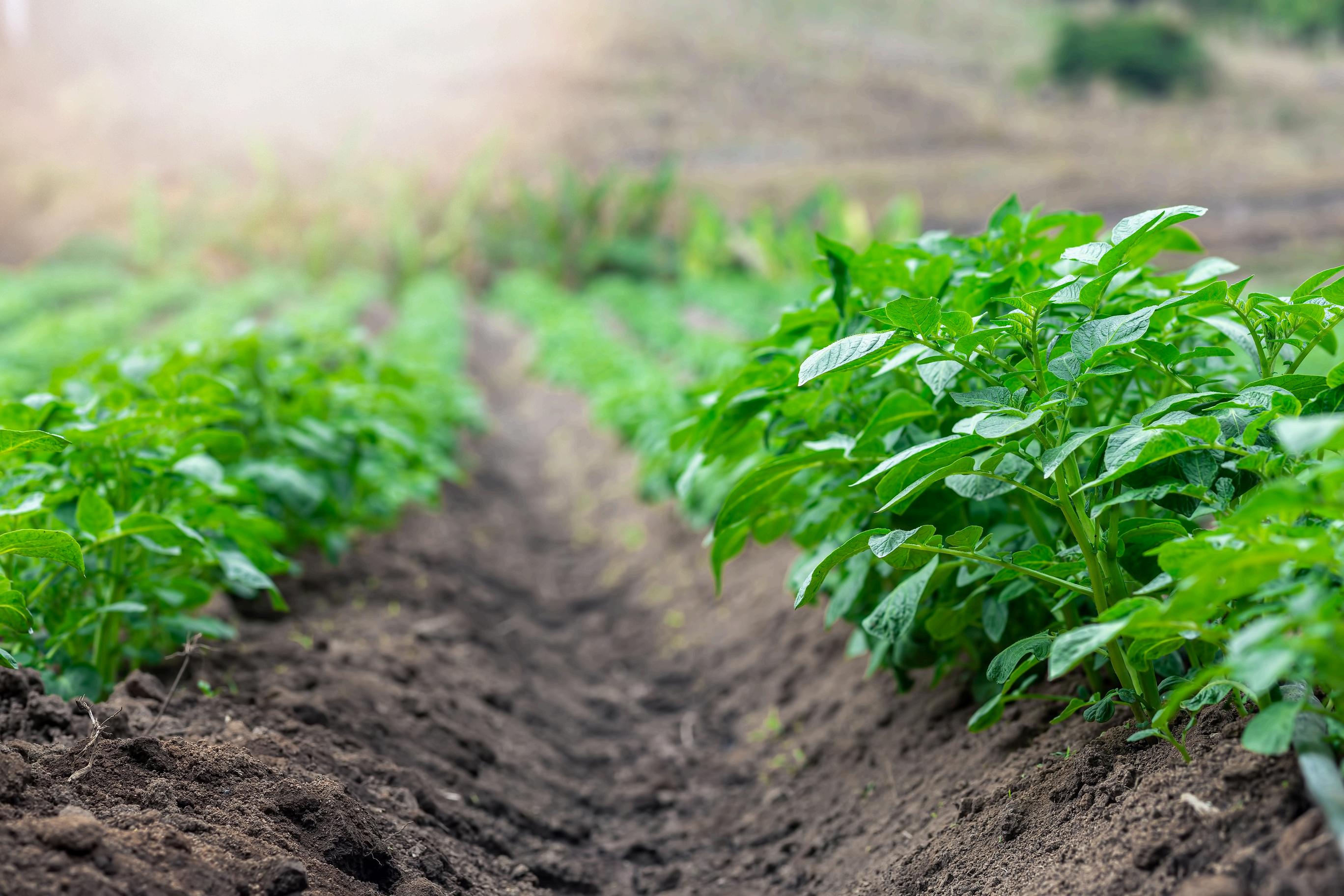

Summary

Supporting agricultural technology (AgTech) innovation is essential for the future prosperity of the United States. But federal government support for research and development in this space has been decreasing, risking our competitive advantage in AgTech. Private sector investment does not and will not pick up the slack for the crucial role public sector funding serves.
To prioritize AgTech advancement in the United States, critical gaps in federal government support need to be efficiently addressed in three key areas: generating foundational knowledge for agricultural innovation, translating and scaling-up AgTech, and building an efficient AgTech implementation ecosystem.

g g g g g
impactful technology implementation requires a functional and efficient innovation ecosystem, Triple Helix launched an initiative to explore inflection points in the U.S. AgTech pipeline where targeted federal government support could catalyze growth.
Stakeholder perspectives were gathered through a series of cross-sector roundtables in New York, Illinois, California, and North Carolina. Participants included academic researchers, start-up founders, investors, commodity group representatives, farmers, and agribusiness leaders, among others This report represents a synthesis of their responses and demonstrates the crucial role that the federal government must play in advancing American leadership in AgTech.

Agriculture is the backbone of the United States, and agricultural success is key for securing the future of American prosperity and competitiveness – from energy and defense to health and nutrition.
But American agricultural production currently faces many challenges. From pests and diseases and severe weather events that ravage yield to volatile supply chains that affect input prices, it is necessary to develop enhanced strategies for agricultural resilience. At the same time, our agriculture also contributes to serious environmental damage. For example, excess nutrients from fertilizer application cause pollution in our waterways, reducing water quality and threatening biodiversity.
AgTech tools like crop biotechnology and artificial intelligence can help secure and improve American agricultural productivity while also protecting precious natural resources.

[ag-tek]•noun• AgTech
Agriculture Technology (AgTech for short) refers to technological innovations applied to the production of goods traditionally reliant upon land-based agriculture. AgTech tools are diverse: they include biotechnologies like genetic engineering, digital tools like artificial intelligence, and mechanical advances like sensors and robotics.
These technologies can improve current methods of land-based production, such as creating drought-tolerant crops, or they can be used to shift the way a product is made to no longer require land in the ways it has traditionally.
Reestablishing U.S. Leadership in AgTech is
Crucial for National Competitiveness
Historically, the United States Government has strongly supported agricultural research and development, laying the foundation for a flourishing agricultural sciences industry. American leadership in agricultural innovation has been facilitated by interactions and collaborations among our powerhouse research institutions, innovative private sector, and forward-looking government.
The United States Department of Agriculture Economic Research Service found that from 1900 to 2011, every $1 in U.S. public sector agriculture R&D funding generated $20 of benefit to the U.S. economy.1
This legacyis at risk.
U.S. public sector spending in agriculture R&D, the majority of which is allocated from the federal government, has fallen behind other nations, declining by about a third since 2002 (in const

United States public sector funding for agriculture R&D has fallen by aboutathirdsince2002 Source:USDAERS,2022 1
The European Union now spends 50% more than the U.S. in agriculture research, and China’s investment outspends the U.S. 2

The United States is falling behind other countries in public sectoragricultureR&Dinvestment.Source:USDAERS,2022 1
Due to constant agricultural pressures like weather and pests, it is understood that steady increase in agricultural R&D is necessaryjust to maintain productivitylevels, let alone improve them.
With a lag time of around 30 years between agricultural R&D investment and actualized gains in productivity, we are likely not yet even fully experiencing the effects of this significant spending decrease in practice. While private sector investment in agricultural R&D has been increasing, it has been shown to serve a complementary role and does not replace the essential functions of public sectorsupport 2 3
Innovations are emerging that have the capacity to transform agricultural productivity and resilience But it is unclear whetherthe U.S.will lead the cutting-edgeAgTech space.
One of these technologies is the revolutionary CRISPR gene editing system. In the first five years after its discovery, Chinese entities filed 60.5% of the patents using this technology in plants, followed by 26% filed by U.S. firms. China has approved the cultivation of multiple gene edited crop varieties as the country aims to decrease dependence on imports and ensure long-term food security. 4 5,6
PercentageofCRISPRpatentsforuseinplants,2012-2017
Source:Martin-Laffonetal,2019
Meanwhile, the U.S. has recently flipped from being a net exporter of agricultural products to a net agricultural importer, largely driven by demand for crops like fruits and vegetables currentlygrown abroad.7
Bipartisan testimony before Congress has highlighted in no uncertain terms that food security is national security But decades-long trends in federal government support are eroding American competitiveness and threatening agricultural productivityand resilience. 8
To secure our agricultural future, advancing American leadership in AgTech must be an all-of-government priority now.
As we look toward the next era of American agricultural leadership, the federal government has a keyrole to playin building an AgTech ecosystem that sustains us in the present and prepares us formanygenerations to come.

CaseStudies
AgTech can be applied to address many agricultural challenges.

Citrus Greening
Citrus greening is a bacterial disease that is completely decimating the citrus industry in states like Florida. Since the first detection of the disease in Florida in 2005, 75% of orange production and 85% of grapefruit production have been lost.9
AgTech strategies such as biological sprays targeting the infection and genetically engineered citrus plants that can resist greening are in the commercialization pipeline If effectively implemented in the field, tools like these could tackle this disease and restore theAmerican citrus industry.

Fertilizer Price Volatility
The United States relies heavily on natural gas and imported raw materials such as potash and phosphate rock for fertilizer production, leaving our fertilizer supply chain vulnerable to geopolitical conflict, trade restrictions, and energy price volatility.10,11
From distributed green ammonia that decouples nitrogen production from natural gas to biological products that harness naturally occurring microbes to deliver nutrients directly to the plant throughout the growing season, AgTech tools could offer local, reliable, and affordable inputs for farmers while enhancing U.S. agricultural resilience.

Drought
Severe drought has threatened crops in recent years, such as in 2022 when wheat yields in states like Oklahoma and Kansas were devastated. In 2024, it was estimated that $11 billion of cropvaluewas lost to drought, extreme heat, andwildfires. 12,13 14
At the same time, aquifers across the country are dangerously overused and depleted, limiting the continued viability of agricultural irrigation.15
From genetically engineered drought tolerant crops to artificial intelligence-enabled remote sensing that can monitor water use and predict climate conditions, AgTech tools could help farmers respond to extreme weather while responsibly managing precious natural resources.

Through in-person roundtable discussions across the country, we asked cross-sector AgTech stakeholders to share their perspectives on what roles the federal government could play in catalyzing U.S. AgTech innovation. Participants encompassed all stages of the AgTech innovation ecosystem, from academic researchers and start-up founders to investors and agribusiness leaders to commodity group representatives and farmers.
Stakeholder insights emphasized the necessity for the federal government to serve essential functions across all stages of the U.S. AgTech ecosystem, but common themes emerged regarding critical gaps where current federal government mechanisms fall short.

Key opportunities for the federal government to address these needs were identified They fall into three categories: generating foundational knowledge for agricultural innovation, translating and scaling-up AgTech, and building an efficientAgTech implementation ecosystem.
While the opportunities described here are by no means exhaustive, they would be meaningful for catalyzing the advancement of awide range ofAgTech innovations.

Opportunities identified for the federal government to catalyze AgTech fell into three categories. These categories are interdependent and continuously influence each other. Combined, they form an effective U S AgTech innovation ecosystem
GeneratingFoundationalKnowledgefor AgriculturalInnovation
Foundationalknowledgeisthebaseofalldiscovery.
For agricultural innovation, we need strong fundamental understanding and reliable data on topics like plant genome sequencesandfunctions,mechanismsofactionforpestsand diseases, microbial interactions that occurin the soil, efficacy of farming inputs and practices, and tracking of weather conditions.Today,wesurprisinglyhaveverylimitedinformation inmanyoftheseareas.
Forexample,welackrobustgenomicanalysisinawidevariety of agricultural species, particularly specialty crops that historically have not been as heavily prioritized for crop improvement. More extensive foundational plant biology knowledge is necessaryif tools like gene editing are to reach theirtechnicalpotentialinpractice.
Key opportunities for the federal government to strengthen knowledge generation and discovery include: prioritizing fundamental research, facilitating data accessibility, and becomingproactive.


Prioritize fundamental research
Championing scientific knowledge generation through government laboratories and direct grants to research institutions has long been an essential service of the federal government. The private sector is ill-suited and has little incentive to participate in this type of long-term scientific inquiry.
Strengthening its commitment to foundational agricultural research could reestablish the federal government’s leadership role in this area of national strategic importance.

Facilitate data accessibility
The ability to manage fundamental scientific resources is a distinctive role of the federal government
Following the model of successful examples, increasing publicly managed open-source agricultural data can enable research across scales and accelerate the design of effective digital AgTech tools, including applications of artificial intelligence. 16
Additionally, managing open-source genetic data can expedite urgent discoveryin crop improvement.

Become proactive
Public sector agricultural research programs often focus on incremental improvement reactive to existing pressures rather than high-risk high-reward transformative opportunities that target long-term resilience and prepare us forfuture threats.
Directing federal government support to proactive highimpact efforts that can pursue transformative technologies unconstrained by current market or policy paradigms would be an important step toward overcoming present and future agricultural challenges.
TranslatingandScaling-up AgTech
Toturnideasfromdiscoverystageintosuccessfulcommercial applications,start-upcompaniesmustsurvivecrucialinflection points, commonly called “valleys of death.” Private sector risk capital models frequently are not sufficiently equipped to support AgTech entrepreneurs during these transitions betweeninnovationstages.
For example, the U.S. has a sophisticated venture capital ecosystem, but it is often volatile and was designed for software-like scale, fast exits, and short return cycles. This is misaligned to the realities of AgTech, which involve longer timelines, regulatory hurdles, seasonal adoption cycles, and hardware-heavy scale. It is therefore particularly challenging for AgTech entrepreneurs to attract the necessary capital to succeed.
Throughavarietyofmechanisms,thefederalgovernmentcan serveasacatalystforAgTechtranslationandscale-upbyderisking new innovations, leveraging public capital to unlock furtherprivatesectorinvestmentandcommercialgrowth.
Ke oppo t nities fo the fede al go e nment to foste


SupportAgTech translation
Funding gaps can impede the advancement of innovation from the research lab or pilot scale to demonstrating commercial viability.
Strategic federal government support can effectively address this “missing middle” phase of funding, but currently existing federal programs are often insufficient due to convoluted processes, lengthy application timelines, and quantities of funds that do not match stakeholders’ needs
Explicitlyprioritizing promptness and clarityin addition to dollar amount could substantially improve how federal government translational funding servesAgTech innovators.

Encourage advanced procurement
Demonstrating market viability is vital forAgTech companies to survive thevalleyof death.
The federal government can play a catalytic role by serving as an early customer, creating demand certainty that attracts private investment and accelerates scale-up. Precedents for federal government advanced procurement exist, but expansion specifically focused on AgTech is needed to match the speed and scale required for today’s agricultural challenges.

Provide loan guarantees
Through loan guarantee programs, the federal government can de-risk lending to start-up companies at critical times in theirscalingwhen theymayotherwise have difficultyaccessing capital and draw market attention toward innovation with national strategic importance.
To have meaningful effect, federal government loan guarantees specifically available to emerging AgTech companies are necessary in addition to those for firms employing more established tools, as entirely new innovations represent higherrisk.
Building an Efficient AgTech Implementation Ecosystem
No technologyhas impact if it isn’t implemented effectively.
The federal government plays a key role in deciding if and how AgTech innovation is used in practice. This implementation ecosystem doesn’t only affect products at the final stages of commercialization; it also has powerful and wide-ranging impacts on earlierstages of the innovation pipeline.
For example, regulatory processes represent more than just a substantial bottleneck for AgTech commercialization. Regulation can affect the prioritization of basic and translational research topics due to whether the work will have any potential for real-world impact, and it can impact private capital allocation to entrepreneurs because considerable l t b d t i t i l i ifi t i t t


Create consistent and streamlined regulation
Lengthy, outdated, and uncertain regulatory processes make up part of the lag time between agricultural R&D investment and realizing impact in practice.
Current timelines can stall or even kill breakthrough innovations before they ever reach scale, no matter how much capital is available. It can be years between submitting a dossierforconsideration and receiving regulatoryapproval. For novel products, a functional regulatory pathway may not yet exist orconflicting pathways among agencies maybe in place
Informed by science-based risk analysis, focused federal government attention could create forward-looking U.S. regulation forAgTech products that propels innovation.

Strengthen farmer-innovatorcommunication
Multi-directional exchange of information between agricultural researchers, private sector AgTech entities, and farmers can increase the likelihood that newAgTech products are designed to address critical needs and meet key criteria, therefore increasing adoption of the innovation once commercialized.
The federal government could foster this engagement and encourage partnerships among stakeholders, ensuring that resources are efficientlyspent on developingAgTech tools that will drive impact.

Set data interoperabilitystandards
Currently, data formats for monitoring farm information are inconsistent across service providers as there is no effective unified standard.
This lack of data interoperability makes it laborious for farmers to pool data between systems or change system. It also hinders conducting comprehensive research on farm management and developing artificial intelligence approaches, as datasets cannot be combined.
Lack of standards is a top barrier to the adoption of data driven technologies in agriculture, but there is no incentive for private companies to adopt universal standards on their own. The federal government could take action in this space by facilitating data interoperabilitystandards. 17
Conclusion

Agricultural productivity and resilience are key to the prosperity and security of the United States. Therefore, advancingAmerican leadership inAgTech is essential. Decades of declining public sector support for this space jeopardize American agricultural success and leave us at a competitive disadvantage on the global stage. While innovation across sectors is paramount, private sector investment does not replace the crucial nature of public sectorsupport.
The opportunities for federal government engagement outlined in this report were synthesized from the insights of AgTech leaders in the United States. Further consultation with these stakeholders can more concretely define actions to be taken. Additionally, state governments may be able to complement federal activities, further driving regional advancement ofAgTech innovation.
American prosperity - from health and nutrition to energy and defense - depends on a strong commitment to innovation in agriculture. Reestablishing and optimizing federal government leadership inAgTech is imperative.

The wonderful hosts of Triple Helix’s cross-sector roundtable sessions:
IndieBio NY - NewYork, NY
Portal Innovations - Chicago, IL
AgStart - Woodland, CA
North Carolina BiotechnologyCenter - Durham, NC
Individuals who reviewed and provided feedback on this report before its release.
References
1. USDAERS(2022) InvestmentinUS PublicAgriculturalResearchand DevelopmentHasFallenbyaThirdOverPastTwoDecades,LagsMajorTrade Competitors https://wwwersusdagov/amber-waves/2022/june/investment-in-u-spublic-agricultural-research-and-development-has-fallen-by-a-third-over-past-twodecades-lags-major-trade-competitors.
2. Ortiz-Bobea,A.etal.(2025).LargeincreasesinpublicR&Dinvestmentare neededtoavoiddeclinesofUSagriculturalproductivity.ProceedingsoftheNational AcademyofSciences.https://doi.org/10.1073/pnas.2411010122.
3. Fuglie,K etal (2012) Thecontributionofprivateindustrytoagricultural innovation Science https://doiorg/101126/science1226294
4. Martin-Laffon,J etal (2019) WorldwideCRISPRpatentlandscapeshowsstrong geographicalbiases NatureBiotechnology https://doiorg/101038/S41587-019-01387
5. Cohen,J (2019) Tofeedits14billion,Chinabetsbigongenomeeditingofcrops Science.https://doi.org/10.1126/science.aay8951.
6. Reuters(2024).ChinaapprovesmoreGMcropstoboostyields,ensurefood security.https://www.reuters.com/markets/commodities/china-approves-more-gmcrops-boost-yields-ensure-food-security-2024-12-31/.
7. USDAERS(2025) AgandFoodStatistics:ChartingtheEssentials-Agricultural Trade https://wwwersusdagov/data-products/ag-and-food-statistics-charting-theessentials/agricultural-trade
8. HearingBeforetheCommitteeonAgriculture,HouseofRepresentatives(2024) “TheDangerChinaPosestoAmericanAgriculture” https://agriculturehousegov/calendar/eventsingleaspx?EventID=7738
9. Nelson,D.(2019).75percentofFlorida’sorangeshavebeenlosttodisease.Can sciencesavecitrus?https://www.universityofcalifornia.edu/news/75-percent-floridasoranges-have-been-lost-disease-can-science-save-citrus.
10. USDAERS(2025).FertilizerUseandPrice-SummaryofFindings. https://www.ers.usda.gov/data-products/fertilizer-use-and-price/summary-offindings
11. USDAERS(2023) GlobalFertilizerMarketChallengedbyRussia’sInvasionof Ukraine https://wwwersusdagov/amber-waves/2023/september/global-fertilizermarket-challenged-by-russia-s-invasion-of-ukraine
12. OklahomaStateUniversity(2022) WesternOklahomafaceswheatcrop devastation https://newsokstateedu/articles/agriculture/2022/western-oklahomafaces-devastating-wheat-crop.html.
13. Condos,D.(2023).Howbadwasthe2022drought?Forthese7Kansas communities,itwasthedriestonrecord.HighPlainsPublicRadio. https://kansaspublicradio.org/health-news/2023-01-23/how-bad-was-the-2022drought-for-these-7-kansas-communities-it-was-the-driest-on-record.
14. Munch,D (2025) Hurricanes,HeatandHardship:Counting2024’sCropLosses AmericanFarmBureauFederation https://wwwfborg/market-intel/hurricanes-heatand-hardship-counting-2024s-crop-losses
15. Mieno,T etal (2024) Aquiferdepletionexacerbatesagriculturaldroughtlosses intheUSHighPlains NatureWater https://doiorg/101038/S44221-023-00173-7
16. OpenET.https://etdata.org/.
17. GAO(2024).PrecisionAgriculture:BenefitsandChallengesforTechnology AdoptionandUse.https://www.gao.gov/products/gao-24-105962.
@triplehelixinstitute
/company/triple-helix-institute www.triplehelix.institute
